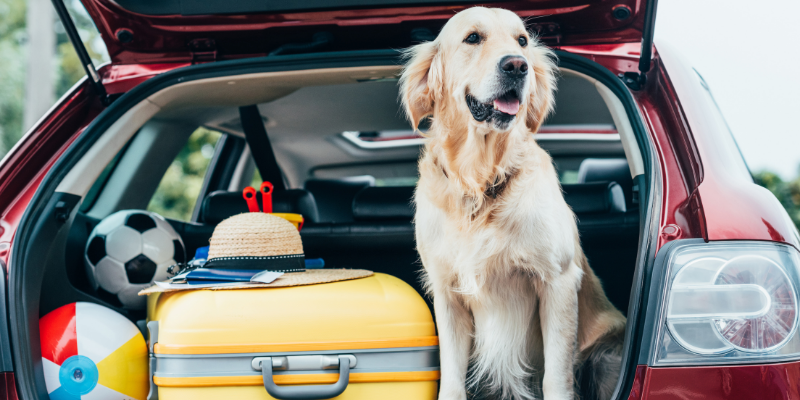Best Dog Travel Tips
Complete Guide for Dog Owners
Most pup parents assume that traveling with your dog is difficult, complicated, and even dangerous. They couldn’t be more wrong! Traveling with your dog is not only easier than you think, but it can be one of the most rewarding experiences.
Proper planning is essential. Once you’ve made the decision to include your furry best friend in your travel plans, follow these 10 best dog travel tips to plan properly.

Table Of Contents

Health Check
1) Take Your Dog For a Check-Up
Travel is not nearly as fun when you aren’t feeling well. The same is true for your dog. It’s a good idea to make sure your pup is in good health before you make full travel plans with them.
Book an appointment with your dog’s veterinarian at least a few weeks before you plan to go on vacation. It’s best to do a full check-up, including blood tests.
Don’t neglect this step, even if your dog is young and seems perfectly healthy! The veterinarian may be able to catch a medical condition early and step in with treatment before symptoms manifest.
Apart from that, certain countries won’t allow a dog across their borders if they don’t have a vet’s certificate stating that they’re healthy and free from disease.
It would also be a good opportunity to ask the vet’s advice about feeding and dog care while you’re traveling. They may be able to offer some advice or prescribe medication to calm your dog or ease a queasy stomach while traveling.
2) Make a Checklist of Food and Medication
It can be easy to forget about your dog’s food and water when traveling. If you’re going to fly to your destination, food is something we humans don’t have to think about, as it’s all taken care of for us. We also don’t tend to pack a lot of food for ourselves, as we just buy on-the-go.
But you’ll need to put some thought into your dog’s food. You can’t carry a big bag of dog food around with you. If you’re going for a short time, it’s possible to measure out the right amount of dog food and take it with you. If you’re away for an extended period of time, it may be a good idea to find a store nearby where you can buy a small bag of your dog’s food just for the trip.
Don’t forget to take dog treats too! Once your food preference (bringing or buying) has been decided, we recommend making a list of whatever medication your dog is on or may need while traveling. These may be chronic meds, or something generic if your dog is prone to things like diarrhea.
3) Find the Closest Animal Medical Center
Nobody wants to think about it, but accidents do happen. Maybe your dog eats something that disagrees with their stomach. Perhaps they get into an argument with another dog. Whatever it is, emergency medical care is something you need to be prepared for.
Your first step is to find an animal medical center at your destination. You want this information close at hand when you’re traveling, so you know exactly where to go in case of an emergency.
Do some research and take down the details of the facility closest to your accommodation. Jot down their phone number, email address, physical address, and the names of the veterinarians. It’s a good idea to keep this information on your phone, but also to write it down on two or three slips of paper, and keep one in your suitcase, and another next to your bed.

Travel Gear
4) Invest in Proper Dog Collars and Tags
Make sure your dog has a sturdy collar with a well-made tag. On the tag, your name and contact details should be easy to read. If your dog has been wearing a tag for years, double-check it before you go! It may have faded or broken, and need to be replaced before you go.
Choose a collar that’s made of durable material that isn’t likely to break easily. We recommend leather. Make sure it fits your dog snugly but doesn’t choke them! A metal tag is a good idea, with your dog’s name and your contact number engraved on it. Make sure it’s connected to the collar with a sturdy metal ring that isn’t going to fall off easily.
5) Find a Reliable Dog Crate for Traveling With Your Dog
Whether you fly or drive, a dog crate is a helpful accessory to have. If you’re flying, check the airline requirements for your dog crate. Dimensions and safety features need to meet their standards.
If you’re driving, a dog crate can keep your dog safe in the car. You can invest in a doggy seatbelt, but a crate will be more comfortable and safer.
If you have to leave your hotel room without your dog, leaving them in their crate will ensure that you don’t come back to chewed furniture or messes all over the room!
Make sure the crate you choose is made of sturdy material, doesn’t have any sharp edges or pieces, and is big enough for your dog. Most airlines will require a solid-sided crate.
6) Pack for Your Dog
Your pet can’t pack for himself! Here’s what you need to add to his bag:
- Travel Bed/Blanket
Depending on where you’re traveling to, your dog may need an extra warm bed and blanket. Regardless of the weather, though, he needs a comfy spot to settle down. Don’t assume your pet can sleep on the bed with you! Most hotels don’t allow this.
- Collapsible Food and Water Bowls
Bowls take up a lot of space, which is why we recommend collapsible food and water bowls. These take up hardly any space and work well for their purpose!
- Dog Brush
Your dog still needs to stay clean and tangle-free while you’re traveling! Don’t forget to take their dog brush along. It could also be a way of calming them if they get a bit stressed.
- Dog Booties
Whether you’re in a hot or a cold place, your pup’s paws need protecting! Dog booties are a great investment. They’ll keep your pet’s toes safe on hot sidewalks and warm in snowy conditions.
- A Warm Jacket (if necessary)
If you’re heading to a cold place with your pet, take a warm jacket for them. Dogs may have fur, but they can get cold just like we can. Wrapping them in their own little warm jacket will keep them comfortable and warm, so they can enjoy the travels as much as you do!
- Hiking Pack
If you’re going to be hiking, get your dog his own pack! He can carry his own water and food bowls, his jacket (for when he needs it), snacks, and other items that aren’t too heavy.
- Extra Collar & LED Collar Light
Collars can break! Don’t run the risk of finding your dog without a collar. Take an extra one along, even if it’s a cheaper one. An LED collar light is a great idea so you can spot your dog even in the dark – you’ll never lose him!
- Hands-Free Leash
If you want your hands free to take photos, use your GPS, or just simply for safety purposes, a hands-free leash is a great item to have with you. Not only do they offer a bit of extra storage space for your valuables, but it’s a much more natural way for you and your pet to explore the place together comfortably.

Planning Accommodations
7) Choose Pet-Friendly Accommodation
Do your research in advance. Some hotels and motels allow pets of all sizes, while others only allow small dogs. Make sure your pooch is the right size for your accommodation!
Once you find a dog-friendly place to stay, it’s a great idea to call ahead and find out if there’s anything you need to bring for your pet. Some will provide bedding, bowls, and even treats for your pup. Others require that you bring everything to care for your pooch.
Even if the place is dog-friendly, it’s your responsibility to keep your pet from chewing on furniture, messing in the room, or disturbing others. Keep in mind that even though your accommodation is friendly towards dogs, not all other guests may be!
8) Double-Check Airlines’ Pet Policies
Just like the above point, all your planning will be in vain if you arrive at the airport and you don’t meet the airline’s pet policies. Every airline is different, so if you’ve flown on a different plane before, don’t assume the policies are the same.
Call the airline that you’re flying with and ask about their pet travel requirements. Some small dogs may be allowed to travel in the cabin, but many will spend the flight in the cargo hold. This requires an appropriate dog crate, kitted out with a water bowl and labeled with your details.
We also recommend booking a direct flight wherever possible. Your pup will be stressed as it is, and a layover or flight change will most likely worsen their stress. The less time they can spend in a crate in a plane, the better!
9) Bring Your Dog’s Medical Info
Find out exactly what medical documents your pup needs for your destination country. Some countries need a vet’s certificate stating your dog is healthy. Others need specific documentation proving your dog is free of specific diseases, like rabies or dysentery.
If your dog has a pet insurance policy, keep those details handy too. It’s a good idea to find out their policies on travel and travel-related claims before you go, rather than make a claim and find out later it’s not covered.
You may also need a vet’s prescription for some of your dog’s medication. Even if you’re taking vet-prescribed dog kibble with you, ensure you have the necessary documents to make the customs experience as smooth as can be.
10) Use Dog-Friendly Apps
Everyone has a smartphone, so why not make use of dog-friendly apps to help make your travels easier? The right apps can help you find appropriate accommodation, dog-friendly activities, and the best places to take your pup for lunch.
Here are some that we recommend:
- DogLog: Your all-in-one guidebook on your own dog! Keep track of health information, important contact details, and medicine schedules (iPhone, Android).
- Pet First Aid: Developed by the American Red Cross, this app offers step-by-step guidance for emergencies (iPhone, Android).
- BringFido: Find where to stay, what to do, and where to eat with your dog, all in one handy app (iPhone, Android).
- Rover: Even when you’re on vacation, you never know when you may need a pet sitter or a dog walker. Great for business trips (iPhone, Android).
- Walk for a Dog: Pick an animal charity and let your steps earn dollars for them! Ideal for those vacations in which you’ll be doing a lot of walking (iPhone, Android).

Ensuring Safety
11) Create a Dog First Aid Kit
You can never be too careful! Here are some things we recommend putting together and keeping with you in case of emergency:
- Bandages, gauze, & saline solution
- Antiseptic ointment
- Tweezers
- A tick removal kit
- Eye wash
We suggest placing this little kit into the storage pouch of your hands-free leash, so you have it within reach if something happens while you’re out.
12) Choose the Right Size Crate
Whether you’re traveling by air or by car, sizing your dog’s crate properly is essential for both comfort and safety. If it’s too small, your dog will be cramped and sore. If it’s too large, your pet might mess in it or they could be hurt if the movement of a car throws the crate around a bit.
The crate should be large enough for your dog to stand without their head or ears touching the top, turn around comfortably, and lie down like normal. Here’s a great article to help you properly measure your dog to choose the right sized crate.
13) Consider the Temperature
Most airlines have strict temperature regulations and won’t fly a dog if temperatures are above 85℉ or below 45℉. It’s wise to check the airline’s policy on what happens if this is the case on the day of your flight.
If you’re traveling in winter, try to do most of your traveling during the day when temperatures are warmer. In summer, book night flights if possible to avoid the heat.
If you’re driving, do your best to keep your dog comfortable. A jacket, blanket, and human to cuddle will keep them warm if it’s icy. Try to drive early morning or late in the evening if it’s hot, but do what you can to keep the inside of the car cool.
Remember, your dog is covered in fur. They overheat much quicker than you do.
14) Avoid Flying with Brachycephalic Breeds
Dogs with flat faces or short snouts (known as brachycephalic breeds) are prone to respiratory problems. The change in air pressure when flying can be dangerous for them.
If at all possible, we recommend not flying with these breeds. Some common short-nosed breeds include Pekingese, Pugs, Bulldogs, Boxers, Boston Terriers, Mastiffs, and Shih Tzus.
If you have no other choice but to fly, prepare properly. Most airlines allow short-nosed dogs to travel in the cabin with you. The air pressure is more controlled, and you can keep a closer eye on your dog as they fly.
5) Cater for Your Dog’s Anxiety
Some dogs are anxious flyers. If your dog has never flown before, it’s best to assume that there will be some anxiety.
Whether they’re in the cargo hold or in the cabin with you, do what you can to alleviate their anxiety. Stressed out dogs are more likely to try and escape, which could lead to injury (either from chewing on metal crate bars or trying to claw their way out of their crate).
CBD oil can be an effective way of calming your dog if they’re prone to nervousness. We don’t recommend tranquilizing them unless it’s been recommended by the vet and they’ve given you appropriate tranquilizers.
Even if your dog is on calming meds, give them their favorite chew toy for comfort. It’s also a great idea to place an item of your clothing in their crate (that you’ve recently worn) so they have their beloved owner’s scent with them to calm them down.

Wrapping Up
Holidays are better spent when you don’t have to worry about leaving your beloved pet at home or somewhere else. While it may seem like a stressful experience, it really doesn’t have to be. You just need to prepare ahead and follow the tips mentioned above to make the most out of your trip with your pooch.






